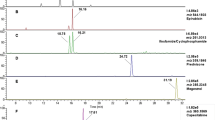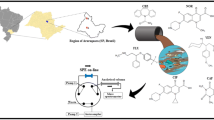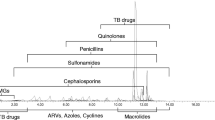Abstract
In the present work, the development, optimization, and validation (including a whole stability study) of a fast, reliable, and comprehensive method for the analysis of ten anticancer drugs in hospital and urban wastewater is described. Extraction of these pharmaceutical compounds was performed using automated off-line solid-phase extraction followed by their determination by ultra-performance liquid chromatography coupled to a triple quadrupole–linear ion trap mass spectrometer. Target compounds include nine cytotoxic agents: cyclophosphamide, ifosfamide, docetaxel, paclitaxel, etoposide, vincristine, tamoxifen, methotrexate, and azathioprine; and the cytotoxic quinolone, ciprofloxacin. Method detection limits (MDL) ranged from 0.8 to 24 ng/L. Levels found of cytostatic agents in the hospital and wastewater influents did not differ significantly, and therefore, hospitals cannot be considered as the primary source of this type of contaminants. All the target compounds were detected in at least one of the influent samples analyzed: Ciprofloxacin, cyclophosphamide, tamoxifen, and azathioprine were found in most of them and achieving maximum levels of 14.725, 0.201, 0.133, and 0.188 μg/L, respectively. The rest of target cancer drugs were less frequently detected and at values ranging between MDL and 0.406 μg/L. Furthermore, a feasible, useful, and advantageous approach based on information acquisition tool (information-dependent acquisition) was used for the screening of human metabolites in hospital effluents, where the hydroxy tamoxifen, endoxifen, and carboxyphosphamide were detected.






Similar content being viewed by others
References
Johnson AC, Jurgens MD, Williams RJ, Kummerer K, Kortenkamp A, Sumpter JP (2008) Do cytotoxic chemotherapy drugs discharged into rivers pose a risk to the environment and human health? An overview and UK case study. J Hydrol 348(1–2):167–175. doi:10.1016/j.jhydrol.2007.09.054
Pomati F, Castiglioni S, Zuccato E, Fanelli R, Vigetti D, Rossetti C, Calamari D (2006) Effects of a complex mixture of therapeutic drugs at environmental levels on human embryonic cells. Environ Sci Technol 40(7):2442–2447. doi:10.1021/es051715a
Santos LHMLM, Araújo AN, Fachini A, Pena A, Delerue-Matos C, Montenegro MCBSM (2010) Ecotoxicological aspects related to the presence of pharmaceuticals in the aquatic environment. J Hazard Mater 175(1–3):45–95
Aga DS (ed) (2008) Fate of pharmaceuticals in the environment and in water treatment systems. CRC Press, Boca Raton, FL
Le Corre KS, Ort C, Kateley D, Allen B, Escher BI, Keller J (2012) Consumption-based approach for assessing the contribution of hospitals towards the load of pharmaceutical residues in municipal wastewater. Environ Int 45:99–111
Osorio V, Perez S, Ginebreda A, Barcelo D (2012) Pharmaceuticals on a sewage impacted section of a Mediterranean River (Llobregat River, NE Spain) and their relationship with hydrological conditions. Environ Sci Pollut Res 19(4):1013–1025. doi:10.1007/s11356-011-0603-4
Petrovic M, Ginebreda A, Acuña V, Batalla RJ, Elosegi A, Guasch H, de Alda ML, Marcé R, Muñoz I, Navarro-Ortega A, Navarro E, Vericat D, Sabater S, Barceló D (2012) Combined scenarios of chemical and ecological quality under water scarcity in Mediterranean rivers. TrAC Trends in Analytical Chemistry 30(8):1269–1278
Ferlay J, Autier P, Boniol M, Heanue M, Colombet M, Boyle P (2007) Estimates of the cancer incidence and mortality in Europe in 2006. Ann Oncol 18(3):581–592. doi:10.1093/annonc/mdl498
Kosjek T, Heath E (2009) Occurrence, fate and removal of pharmaceutical residues in water treatment. Jozef stefan International Posgraduate School, Ljubljana, Slovenia
Custodio JBA, Dinis TCP, Almeida LM, Madeira VMC (1994) Tamoxifen and hydroxytamoxifen as intramembraneous inhibitors of lipid peroxidation. Evidence for peroxyl radical scavenging activity. Biochem Pharmacol 47(11):1989–1998
Besse J-P, Latour J-F, Garric J (2012) Anticancer drugs in surface waters: what can we say about the occurrence and environmental significance of cytotoxic, cytostatic and endocrine therapy drugs? Environ Int 39(1):73–86
Kovalova L (2009) Cytostatics in the aquatic environment: analysis, occurrence, and possibilities for removal. Doctoral dissertation. RWTH Aachen University, Aachen, Germany
SEOM (2010) Principales Fármacos de quimioterapia antineoplásica. Sociedad Española de Oncologia Medica
Zounkova R, Odraska P, Dolezalova L, Hilscherova K, Marsalek B, Blaha L (2007) Ecotoxicity and genotoxicity assessment of cytostatic pharmaceuticals. Environ Toxicol Chem 26(10):2208–2214
Zounkova R, Kovalova L, Blaha L, Dott W (2010) Ecotoxicity and genotoxicity assessment of cytotoxic antineoplastic drugs and their metabolites. Chemosphere 81(2):253–260
Pomati F, Orlandi C, Clerici M, Luciani F, Zuccato E (2008) Effects and interactions in an environmentally relevant mixture of pharmaceuticals. Toxicol Sci 102(1):129–137
Kazner C, Lehnberg K, Kovalova L, Wintgens T, Melin T, Hollender J, Dott W (2008) Removal of endocrine disruptors and cytostatics from effluent by nanofiltration in combination with adsorption on powdered activated carbon. Water Sci Technol 58(8):1699–1706
Kümmerer K, Al-Ahmad A, Bertram B, Wiessler M (2000) Biodegradability of antineoplastic compounds in screening tests: influence of glucosidation and of stereochemistry. Chemosphere 40(7):767–773
Kümmerer K, Steger-Hartmann T, Meyer M (1997) Biodegradability of the anti-tumour agent ifosfamide and its occurrence in hospital effluents and communal sewage. Water Res 31(11):2705–2710
Lenz K, Mahnik S, Weissenbacher N, Mader RM, Krenn P, Hann S, Koellensperger G, Uhl M, Knasmuller S, Ferk F, Bursch W, Fuerhacker M (2007) Monitoring, removal and risk assessment of cytostatic drugs in hospital wastewater. Water Sci Technol 56(12):141–149
Mahnik SN, Lenz K, Weissenbacher N, Mader RM, Fuerhacker M (2007) Fate of 5-fluorouracil, doxorubicin, epirubicin, and daunorubicin in hospital wastewater and their elimination by activated sludge and treatment in a membrane-bio-reactor system. Chemosphere 66(1):30–37
Buerge IJ, Buser H-R, Poiger T, Müller MD (2006) Occurrence and fate of the cytostatic drugs cyclophosphamide and ifosfamide in wastewater and surface waters. Environ Sci Technol 40(23):7242–7250. doi:10.1021/es0609405
Gómez-Canela C, Cortés-Francisco N, Oliva X, Pujol C, Ventura F, Lacorte S, Caixach J (2012) Occurrence of cyclophosphamide and epirubicin in wastewaters by direct injection analysis–liquid chromatography–high-resolution mass spectrometry. Environ Sci Pollut Res 19(8):3210–3218. doi:10.1007/s11356-012-0826-z
Llewellyn N, Lloyd P, Jürgens MD, Johnson AC (2011) Determination of cyclophosphamide and ifosfamide in sewage effluent by stable isotope-dilution liquid chromatography-tandem mass spectrometry. J Chromatogr A 1218(47):8519–8528
Verlicchi P, Galletti A, Petrovic M, Barceló D (2011) Hospital effluents as a source of emerging pollutants: an overview of micropollutants and sustainable treatment options. J Hydrol 389:416–428
Weissbrodt D, Kovalova L, Ort C, Pazhepurackel V, Moser R, Hollender J, Siegrist H, McArdell CS (2009) Mass flows of X-ray contrast media and cytostatics in hospital wastewater. Environ Sci Technol 43(13):4810–4817
Yin J, Shao B, Zhang J, Li K (2010) A preliminary study on the occurrence of cytostatic drugs in hospital effluents in Beijing, China. Bull Environ Contam Toxicol 84(1):39–45. doi:10.1007/s00128-009-9884-4
Catastini C, Mullot J, Boukari S, Mazellier P, Levi Y, Cervantes P, Ormsby J (2008) Identification de molecules anticancereuses dans les effluents hospitaliers, vol 39. 85 p. Association scientifique europenne pour l'eau et la sante;Paris. FRANCE, Paris
Steger-Hartmann T, Kümmerer K, Schecker J (1996) Trace analysis of the antineoplastics ifosfamide and cyclophosphamide in sewage water by twostep solid-phase extraction and gas chromatography–mass spectrometry. Journal of Chromatography A 726(1–2):179–184
Kovalova L, Siegrist H, Singer H, Wittmer A, McArdell CS (2012) Hospital wastewater treatment by membrane bioreactor: performance and efficiency for organic micropollutant elimination. Environ Sci Technol 46(3):1536–1545. doi:10.1021/es203495d
Mahnik SN, Rizovski B, Fuerhacker M, Mader RM (2004) Determination of 5-fluorouracil in hospital effluents. Anal Bioanal Chem 380(1):31–35. doi:10.1007/s00216-004-2727-6
Yin J, Yang Y, Li K, Zhang J, Shao B (2010) Analysis of anticancer drugs in sewage water by selective SPE and UPLC-ESI-MS-MS. J Chromatogr Sci 48(10):781–789. doi:10.1093/chromsci/48.10.781
Kümmerer K, Al-Ahmad A (2010) Estimation of the cancer risk to humans resulting from the presence of cyclophosphamide and ifosfamide in surface water. Environ Sci Pollut Res 17(2):486–496. doi:10.1007/s11356-009-0195-4
Rowney N, Johnson A, Williams RJ (2009) Cytotoxic drugs in drinking water: a prediction and risk assessment exercise for the Thames catchment in the United Kingdom. Environ Toxicol Chem 28(2):2733–2743
Sissi C, Palumbo M (2003) The quinolone family: from antibacterial to anticancer agents. Current Medicinal Chemistry - Anti-Cancer Agents 3(6):439–450
Cha JM, Yang S, Carlson KH (2006) Trace determination of b-lactam antibiotics in surface water and urban wastewater using liquid chromatography combined with electrospray tandem mass spectrometry. J Chromatogr A 1115(1–2):46–57
Hernandez F, Sancho JV, Ibañez M, Guerrero C (2007) Antibiotic residue determination in environmental waters by LC-MS. TrAC Trends in Analytical Chemistry 26(6):466–485
Gros M, Rodriguez-Mozaz S, Barcelo D (2012) Fast and comprehensive multi-residue analysis of a broad range of human and veterinary pharmaceuticals and some of their metabolites in surface and treated waters by ultra-high-performance liquid chromatography coupled to quadrupole-linear ion trap tandem mass spectrometry. J Chromatogr A 1248:104–121
Matuszewski BK, Constanzer ML, Chavez-Eng CM (2003) Strategies for the assessment of matrix effect in quantitative bioanalytical methods based on HPLC-MS/MS. Anal Chem 75(13):3019–3030. doi:10.1021/ac020361s
FDA (2011) Studies to evaluate the metabolism and residue kinetics of veterinary drugs in food-producing animals: validation of analytical methods used in residue depletion studies guidance of industry VICH GL49
Radjenovic J, Perez S, Petrovic M, Barcelo D (2008) Identification and structural characterization of biodegradation products of atenolol and glibenclamide by liquid chromatography coupled to hybrid quadrupole time-of-flight and quadrupole ion trap mass spectrometry. J Chromatogr A 1210(2):142–153
Ferrando-Climent L, Collado N, Buttiglieri G, Gros M, Rodriguez-Roda I, Rodriguez-Mozaz S, Barceló D (2012) Comprehensive study of ibuprofen and its metabolites in activated sludge batch experiments and aquatic environment. Sci Total Environ 438:404–413
Garcia-Galan MJ, Villagrasa M, Diaz-Cruz MS, Barcelo D (2010) LC-QqLIT MS analysis of nine sulfonamides and one of their acetylated metabolites in the Llobregat River basin. Quantitative determination and qualitative evaluation by IDA experiments. Anal Bioanal Chem 397(3):1325–1334. doi:10.1007/s00216-010-3630-y
(2002/657/EC) CD (2002) Commission Decision (2002/657/EC) of 12 August 2002 Implementing Council Directive 96/23/EC concerning the performance of analytical methods and the interpretation of results. Official Journal of the European Communities L221, Brussels, Belgium:8–36.
Marin JM, Gracia-Lor E, Sancho JV, Lopez FJ, Hernandez F (2009) Application of ultra-high-pressure liquid chromatography-tandem mass spectrometry to the determination of multi-class pesticides in environmental and wastewater samples: study of matrix effects. J Chromatogr A 1216(9):1410–1420
Kümmerer K, Al-Ahmad A (1997) Biodegradability of the anti-tumour agents 5-fluorouracil, cytarabine, and gemcitabine: impact of the chemical structure and synergistic toxicity with hospital effluent. Acta hydrochimica et hydrobiologica 25(4):166–172. doi:10.1002/aheh.19970250402
Langford KH, Thomas KV (2009) Determination of pharmaceutical compounds in hospital effluents and their contribution to wastewater treatment works. Environ Int 35(5):766–770
Liu X, Zhang J, Yin J, Duan H, Wu Y, Shao B (2010) Analysis of hormone antagonists in clinical and municipal wastewater by isotopic dilution liquid chromatography tandem mass spectrometry. Anal Bioanal Chem 396(8):2977–2985. doi:10.1007/s00216-010-3531-0
Verlicchi P, Al Aukidy M, Galletti A, Petrovic M, Barceló D (2012) Hospital effluent: investigation of the concentrations and distribution of pharmaceuticals and environmental risk assessment. Sci Total Environ 430:109–118
Jean J, Perrodin Y, Pivot C, Trepo D, Perraud M, Droguet J, Tissot-Guerraz F, Locher F (2012) Identification and prioritization of bioaccumulable pharmaceutical substances discharged in hospital effluents. J Environ Manag 103:113–121
Roberts PH, Thomas KV (2006) The occurrence of selected pharmaceuticals in wastewater effluent and surface waters of the lower Tyne catchment. Sci Total Environ 356(1–3):143–153
Lin Cm, Jiang Yq, Chaudhary Ag, Rimoldi Jm, Kingston Dg, Hamel E (1996) A convenient tubulin-based quantitative assay for paclitaxel (Taxol) derivatives more effective in inducing assembly than the parent compound. Cancer Chemother Pharmacol (0344–5704 )
Kupfer D, Mani C, Lee CA, Rifkind AB (1994) Induction of tamoxifen-4-hydroxylation by 2,3,7,8-tetrachlorodibenzo-p-dioxin (TCDD), beta-naphthoflavone (beta NF), and phenobarbital (PB) in avian liver: identification of P450 TCDDAA as catalyst of 4-hydroxylation induced by TCDD and beta NF. Cancer Res 54(12):3140–3144
Lim Y, Li L, Desta Z, Zhao Q, Rae JM, Flockhart DA, Skaar TC (2006) Endoxifen, a secondary metabolite of tamoxifen, and 4-OH-tamoxifen induce similar changes in global gene expression patterns in MCF-7 breast cancer cells. J Pharmacol Exp Ther 318(2):503–512
Preiss R, Schmidt R, Baumann F, Hanschmann H, Hauss J, Geissler F, Pahlig H, Ratzewiss B (2002) Measurement of 4-hydroxylation of ifosfamide in human liver microsomes using the estimation of free and protein-bound acrolein and codetermination of keto- and carboxyifosfamide. J Cancer Res Clin Oncol 128(7):385–392. doi:10.1007/s00432-002-0335-4
Takamizawa A, Matsumoto S, Iwata T, Tochino Y, Katagiri K, Yamaguchi K (1975) Studies on cyclophosphamide metabolites and their related compounds. 2. Preparation of an active species of cyclophosphamide and related compounds. J Med Chem 18(4):376–383
Kern S, Fenner K, Singer HP, Schwarzenbach RP, Hollender J (2009) Identification of transformation products of organic contaminants in natural waters by computer-aided prediction and high-resolution mass spectrometry. Environ Sci Technol 43(18):7039–7046. doi:10.1021/es901979h
Acknowledgments
This study has been co-financed by the Spanish Ministry of Economy and Competitiveness, and the European Union through the European Regional Development Fund (FEDER), through the national research projects (CTQ2010-21776-C02-02, DEGRAPHARMAC), the European projects (FP7-ENV-2011-ECO-INNOVATION, ENDETECH), and The Catalan Agency for Administration of University and Research Grants (AGAUR, 2009 CTP 00034, MBRMed). This work was partly supported by the Generalitat de Catalunya (Consolidated Research Group: Water and Soil Quality Unit 2009-SGR-965). The authors would further like to thank the Consorci de la Costa Brava, the members of Castell d`Aro WWTP, TRARGISA S.A. (Tractament de Residus i d'Aigües Residuals del Sistema de Girona), and Jose Vicente Bon in charge of Green Office from CHGUV (Consorcio Hospital General Universitario de Valencia). Prof. Barceló acknowledges King Saud University for his visiting professorship.
Author information
Authors and Affiliations
Corresponding author
Additional information
Published in the special paper collection Liquid Chromatography–Tandem Mass Spectrometry with guest editors Damià Barceló and Mira Petrovic.
Electronic supplementary material
Below is the link to the electronic supplementary material.
ESM 1
(PDF 167 kb)
Rights and permissions
About this article
Cite this article
Ferrando-Climent, L., Rodriguez-Mozaz, S. & Barceló, D. Development of a UPLC-MS/MS method for the determination of ten anticancer drugs in hospital and urban wastewaters, and its application for the screening of human metabolites assisted by information-dependent acquisition tool (IDA) in sewage samples. Anal Bioanal Chem 405, 5937–5952 (2013). https://doi.org/10.1007/s00216-013-6794-4
Received:
Revised:
Accepted:
Published:
Issue Date:
DOI: https://doi.org/10.1007/s00216-013-6794-4




